Menus
- Picture book work
- Only engine fragments remained of the F-Type prototypes
- “I have my ideas and concepts in my head"
- Secondary chain drives the rear wheel
- No fuel pump necessary
- Construction of the second engine
- Technical specifications
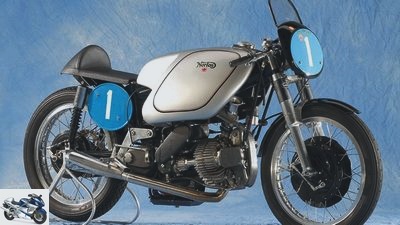
Bilski
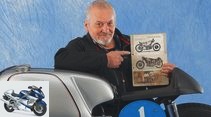


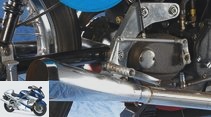
17th photos

Bilski
1/17
One of the few photos that served as a template for the Norton Manx F-Type replica.
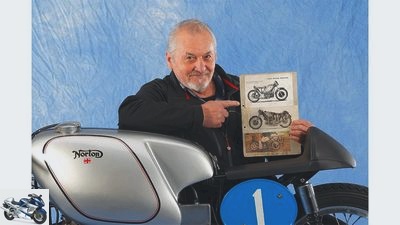
Bilski
2/17
The “Norton-Franz” grinder, passionate craftsman and Manx specialist.
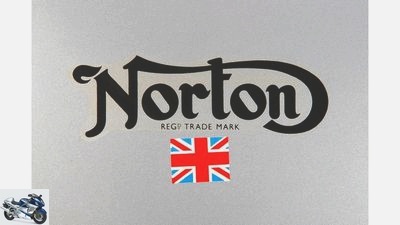
Bilski
3/17
Norton Manx F-Type replica.
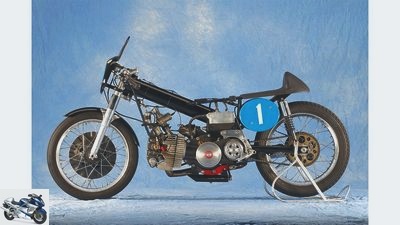
Bilski
4/17
Like the factory F-Type, the replica also has a massive central tubular frame with an integrated control head and oil tank.

Bilski
5/17
A block motor with an integrated gearbox like the original would have been far too complex and therefore expensive. Instead, Franz Schleifer installed a conventional Manx five-speed gearbox in a separate housing for his replica. True to the original, the swing arm is also supported here in solid aluminum profiles
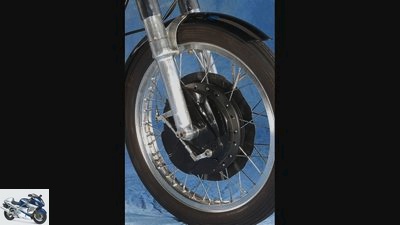
Bilski
6/17
The front one is based on the conical magnesium hub of the Manx, but the ventilated anchor plate and the wave-shaped fan disc are self-made.
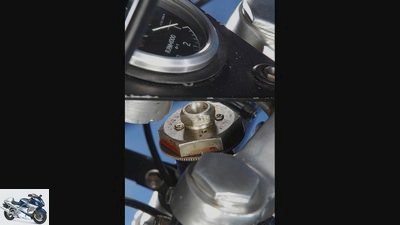
Bilski
7/17
Everything self-made: In addition to the engine, the “Norton-Franz” also built the frame with the swing arm and the brakes itself.
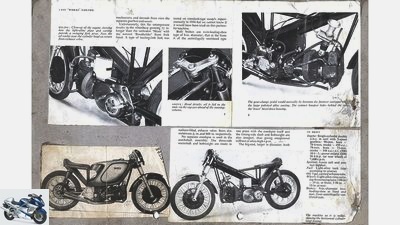
Bilski
8/17
Check the Ripper: the factory prototype with the cooling fins of the standing Manx cylinder (top right). The Norton troop should have changed that.
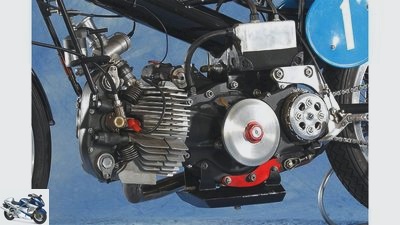
Bilski
9/17
… Then the channels and valve seats had to be milled out of the material.
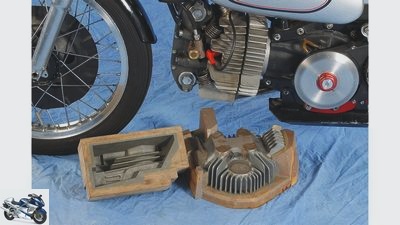
Bilski
10/17
The construction of the cylinder head, which was cast in self-made molds, was even more complex. Since this was done without kernels, …
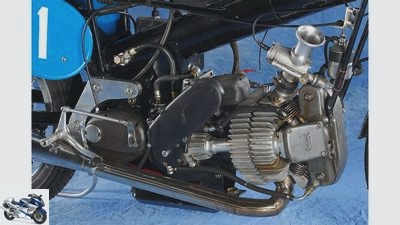
Bilski
11/17
Franz Schleifer carved the cylinder with the horizontally arranged cooling fins from the solid.
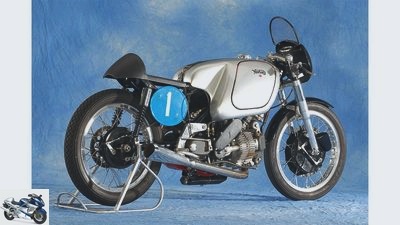
Bilski
12/17
Norton Manx F-Type replica.
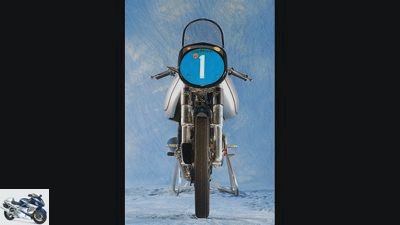
Bilski
13/17
Norton Manx F-Type replica.
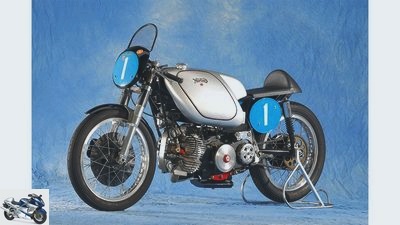
Bilski
14/17
Norton Manx F-Type replica.
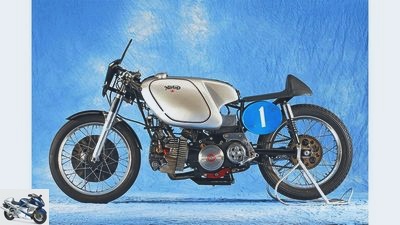
Bilski
15/17
… the "Norton-Franz", built the replica without any construction drawings.
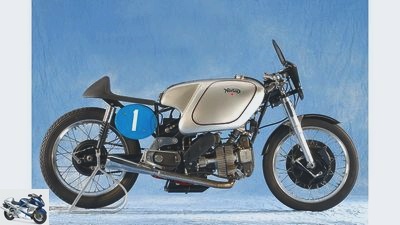
Bilski
16/17
And this is what the result looked like. Franz Schleifer, also called …
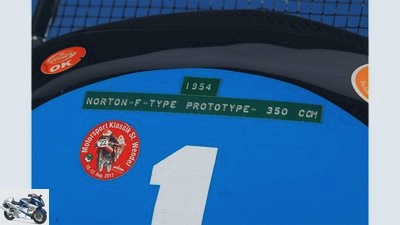
Bilski
17/17
Norton Manx F-Type replica.
Norton Manx F-Type replica in the studio
Picture book work
Content of
As a template for this replica of a lost Manx prototype, Franz Schleifer only had a few photos to hand. The gifted craftsman has built the Norton racing machine with great skill – without a single design drawing!
E.t was in the mid-1980s when Franz Schleifer came across a little book that was to become very important in his life while visiting England. Because the Norton lover and Manx owner discovered a machine in it that impressed him so much with its line that he really wanted it.
Buy complete article
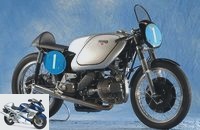
Norton Manx F-Type replica in the studio
Picture book work
Norton Manx F-Type – the F stands for “Flat” and thus the horizontal cylinder – never got beyond the prototype stage. The F-Type was a secret project by a handful of people in Norton’s racing department. Intended as an answer to the victorious Moto Guzzi racers who had wrested the world championship crown in the 350s from the Norton works team in 1953 with just such a lying single-cylinder. But before the promising F-Type could be used, Norton announced the withdrawal of the works team from GP racing at the end of 1954.
Only engine fragments remained of the F-Type prototypes
Of the F-Type prototypes – apart from the 350 series, a 500 series version was also built – there were only engine fragments that were “rescued” by employees of the racing department. And they had no interest in giving out information or parts of it. “Since there is nothing to buy, I just have to build the F-Type myself.” Schleifer’s insight, which is as simple as it is presumptuous, is put into perspective when you know that he is known in the scene as “Norton-Franz”. Not only because he was “still loyal to the Manx as an ID racing driver when the two-stroke engine had long since dominated”. But also because he masters the mechanically extremely complex Manx engine like crazy.
The trained engine fitter and experienced precision mechanic got to work in 1989, building the first engine with defective Manx parts that were already on the shelf. These were repaired and adjusted. “Of course I had doubts whether I could really do it myself,” he admits, “but I just had to try it.”
“I have my ideas and concepts in my head"
And without a single construction drawing, because there wasn’t one. “I have my ideas and concepts in my head. That’s enough if you know what you’re doing. ”Words from a practitioner who probably make their hair stand on end when studying engineers. But it only took about a year for Franz to push his first “prototype” out of the basement workshop at home. As in the original with the cylinder and head of the stationary engine. It was of course clear to him that the ribs were not suitable for the horizontal arrangement. Nevertheless, it worked for some function tests, whereby the engine initially “ran more badly than right”. Typical of a test vehicle, which also only came closer to the model in the photos in many details such as wheels, brakes or seat humps over the years. Then, in 2010, there was a big bang on the Salzburgring. Thermal overload in combination with problems in the oil circuit led to the piston jamming with a connecting rod torn off and a broken motor housing.
Not an unusual fate for a prototype, the Norton factory team would probably have had to put up with such setbacks if the project hadn’t been stopped so suddenly. Which is why Franz did not throw the gun in the grain. The new Manx motor housing tore a big hole in the household budget, but gave the impetus to “do everything right now”. Whereby correct mainly meant an adapted ribbing for the lying arrangement. And thus, among other things, the in-house production of cylinders and heads.
Everything about Norton motorcycles
Secondary chain drives the rear wheel
Only in one point was it certain from the outset that an exact replica would not be possible: The factory F-Type had a unit motor with an integrated gearbox, the primary drive of which required a crankshaft rotating “backwards” via two gear wheels. Too much effort, decided Franz – and built his own solution with the five-speed gearbox of the Manx in the adapted housing. This is why the secondary chain on his Norton Manx F-Type replica drives the rear wheel on the left-hand side, on the original it is exactly the other way around.
Otherwise, however, the 71-year-old has kept the Norton Manx F-Type replica very closely to the model shown in the photos. Of course, this also applies to the striking central tube frame with a diameter of 110 millimeters, which also stores the oil. Franz made it himself from precision steel tubing with a wall thickness of 1.5 millimeters and brazed connections, as well as the mounting of the two-arm swing arm with oval tube cross-sections, made from solid aluminum profiles. The aluminum triple clamps and the brakes are also made in-house by the handicraft artist, with the ventilated anchor plate and the self-made fan disc at the front of the double-cam duplex brake particularly striking for better heat dissipation like the original.
No fuel pump necessary
At the rear he also came up with a specialty: the rear wheel hub is based on the factory racing motorcycles, with a chainring that is separate from the brake hub. This enables a free choice of gear ratio and prevents the hub from overheating due to friction. So it is hardly surprising that the Swabian, who was born in Austria, also welded the elegantly shaped tank from 1.5 millimeter thick aluminum sheets himself. However, it looks much bigger than it actually is, because the voluminous container of the Norton Manx F-Type replica does not hold more than ten liters of fuel. By the way, because the builder subdivided it in such a way that the fuel in the upper area reaches the carburettor according to the downdraft principle, which is why – unlike the original – no petrol pump is required here.
This already shows that Franz Schleifer did not set up his Norton Manx F-Type replica as a mere showpiece. Now, with the adapted ribbing, thermal problems are no longer an issue. The revised oil circuit and an additional oil sump tank under the crankcase also increased reliability. The “Norton crazy”, as Franz Schleifer calls himself, can now fully enjoy his F-Type replica, which he presented to an enthusiastic audience with the new engine three years ago, at his rare public appearances. It’s a mutual pleasure. With his self-construction, which is spectacular in every respect, Franz has shown that it sometimes only takes a few photos to deliver a picture-book work.
Construction of the second engine
Bilski
Here you can see the self-made molds for the cylinder head.
Lay flat
From the beginning it was clear that a unit engine like the one in the original was out of the question – the effort and costs for the molds for a block engine would have been far too expensive. Franz decided to take the parts of an ordinary Norton Manx except for the cylinder and head and combine them with its AMC five-speed transmission. However, this made it necessary to shorten the crankcase in order to keep the wheelbase as compact as possible despite the horizontal cylinder. Franz separated 60 millimeters from the Manx crankcase in the area of the oil sump and closed it with a lid. However, there was no longer any space for the standard crankshaft, which was therefore turned off by 30 millimeters on the lifting discs and rebalanced. The stroke of the standard 500 Manx piston (86 mm) is now 76.6 millimeters, as with the 350. Schleifer worked the cylinder with the horizontal cooling fins from solid pieces.
But the greatest adventure was the cylinder head. Since professional model builders called up priceless sums for a casting mold, Franz got down to work himself. Using the photos, he made a drawing for the dimensions, number of ribs and their position and, with the help of a model maker friend, built the three required molds. To the surprise of the two, the first casting was successful. Since this was done without cores, Franz had to mill the channels and valve seats from solid. The head (valves, springs, bevel shaft and gear cascade including the two camshafts) was then fitted with original Manx parts.
Technical specifications
Bilski
There were no construction drawings. Franz Schleifer had his ideas and concepts in mind.
Norton F-Type replica
Engine: Air-cooled single-cylinder four-stroke engine, arranged horizontally, two valves, bore 86 mm, stroke 76.6 mm, approx. 440 cm³, approx. 45 hp, a 35 Amal GP carburetor, multi-disc dry clutch, five-speed gearbox, chain drive
Landing gear: Central tubular frame, Ø 110 mm, with integrated oil tank, Norton Roadholder fork at the front, two-arm swing arm at the rear, duplex drum brakes at the front and rear, dry weight 132 kg, tank capacity approx. 10 l, tires: 3.00-19 front and 3.50-19 rear
Related articles
-
In the studio: The German Norton NSU 501 OSL
Bilski 12th photos Bilski 1/12 And the NSU carburetor. Bilski 2/12 The NSU 501 OSL in the horizontal view. Bilski 3/12 The finely crafted leather saddle….
-
In the studio: Honda CR 750 Daytona replica
Sdun Honda CR 750 Daytona replica Motorcycle classic: Ready to Race Content of She stands crouched in the studio, she willingly allows herself to be…
-
In the studio – Moto Guzzi Condor
bilski-fotografie.de 18th photos bilski-fotografie.de 1/18 Moto Guzzi Condor. bilski-fotografie.de 2/18 The original engine was removed for performance…
-
Test: Norton 18 H racing machine
Noll Test: Norton 18 H Racing motorcycle from the 1920s Content of In the 1920s, the Norton 18 H was one of the most successful half-liter machines – and…
-
test Moto Guzzi V8 replica Guiseppe Todero built the legendary Moto Guzzi V8 racing machine on his own. One of the most famous factory racing machines…
-
Norton Commando 850, Norton Commando 961 Sport
Cathcart The comparison with the original Norton Commando 850, Norton Commando 961 Sport Content of The newly launched Norton Commando 961 Sport…
-
Scene: Hildebrand & Wolfmuller replica
Bilski Scene: Hildebrand Wolfmuller replica The first to the second Content of Hildebrand Wolfmuller are considered the first series-produced…
-
Siemer 25 pictures Siemer 1/25 Siemer 2/25 Siemer 3/25 Bernd Lienstadt doesn’t need any show talent as a two-wheeled companion. An honest skin is to him …
-
Hercules W 2000, Norton Classic, Suzuki RE5, Van Veen OCR 1000
wolf 47 photos wolf 1/47 The mighty radiator for the 4.5 liters of coolant shapes the front, but keeps the temperature balance in order. wolf 2/47 Brembo…
-
Honda Dream 50 and Honda Dream 50 R in the studio
www.bilski-fotografie.de 22nd photos Bilski 1/22 For the 50th anniversary of the company, Honda made lovers of classic shapes a very special gift in…